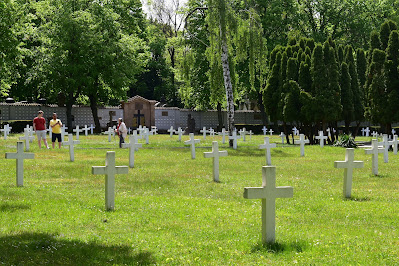One can learn much history from visiting cemeteries. Czech soldiers died for the Austro-Hungarian Empire in wars far from home. Bohemia, home to Slavic peoples, became part of the Holy Roman Empire (the collection of lands ruled by the Habsburg monarchy) in the 12th century. As such, the Slavic-speaking Czechs were ruled by German-speaking overlords for eight centuries before Czechoslovakia was to emerge from the rubble of the Austro-Hungarian Empire in 1918. Meanwhile, Czechs were sent to die abroad in wars that were of no consequence to the lands of the Czechs.
Below: the First World War section of Prague's 60-hectare Olšany Necropolis (Olšanské hřbitovy), the Vojenská pohřebiště (War Cemetery). Here I come across graves dated 1913, reminding me that the two Balkan Wars (1912-1914) were among the key underlying causes of WW1. Tomorrow we celebrate the 20th anniversary of Czechia and Poland joining the EU along with Slovakia, Hungary, Lithuania, Latvia, Estonia, Croatia and Slovenia. Gazing upon these reminders of death and suffering that nationalist tensions brought to our part of the continent, one can only be happy.
Immediately recognisable as a Commonwealth War Grave, this section of the war cemetery contains the bodies of fallen pilots and prisoners of war who died in camps across Nazi-occupied Czechoslovakia. The second row here marks the seven crew members of a RAF Lancaster bomber from 301 (Polish) Squadron, shot down over Prague on 29 December 1944.
Got a bit of a cold (Pt II)
April's end, summer's beginning
This time six years ago:
Best April ever?
This time seven years ago:
The search for the Gold Train: Day Two
This time eight years ago:
Semi-automatic (short story)
This time 12 years ago:
So good to be back in Warsaw
This time 13 years ago:
At the President's
This time 15 years ago:
Summer's here, and the time is right...
This time 17 years ago:
Why I'm staying in Warsaw






No comments:
Post a Comment